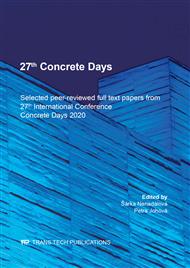p.3
p.9
p.17
p.23
p.28
p.35
p.41
p.48
p.54
The Analysis of the Intensity and Vibration Time on the Mechanical Properties of Hardened Concrete
Abstract:
In order to achieve optimal physical and mechanical properties of hardened concrete, it is necessary to determine the right intensity and vibration time of fresh concrete during casting. Since concrete is considered as a polydisperse substance and various aggregate grains move randomly during vibration, it is very difficult to describe this stochastic phenomenon using exact physical equations and it is more advantageous to apply an experimental approach to verify the effects of vibration on fresh concrete. The effect of vibrations on fresh concrete increases the speed gradient of individual grains and thus reduces the viscosity of the cement paste. The intensity of vibration is determined mainly by the frequency, amplitude and centrifugal force of the eccentric of the vibrating machine. The optimal vibration time is generally considered to be the "minimum required". Insufficient vibration caused by an unsuitable vibrating machine or a short vibration time can result in insufficient compaction of the aggregate grains, non-release of accumulated air from the fresh concrete mixture, formation of cavities or poor-quality casting of parts of the structure with a higher degree of reinforcement. Vibration with excessive intensity or time can also be considered dangerous. The over-compaction of concrete is most often demonstrated by segregation of aggregates. The presented research deals with the determination of the optimal time and intensity of vibration of fresh concrete mixture to achieve the required physical properties of concrete, i.e. high compressive strength and modulus of elasticity of hardened concrete while reducing the negative effects of vibration, especially segregation of aggregates.
Info:
Periodical:
Pages:
28-34
Citation:
Online since:
August 2021
Authors:
Price:
Сopyright:
© 2021 Trans Tech Publications Ltd. All Rights Reserved
Share:
Citation:


